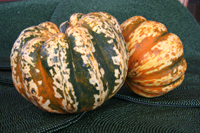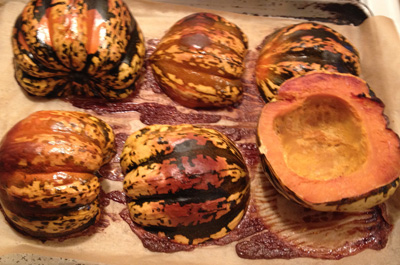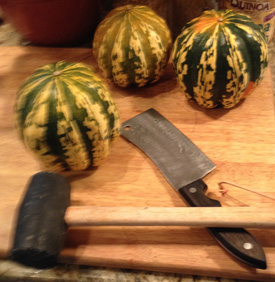Nourish Your Body
With Fabulous Homemade Food
How to Roast A Pumpkin . . . And Other Winter Squashes

First I want to tell you about pumpkins.
I used to make anything “pumpkin” with pumpkin, which is a winter squash. And then one day I was watching a cooking show on television and it was suggested that one make pumpkin pie with kabocha squash instead because they had more flavor than pumpkin squash. So I immediately went and bought a kabocha squash and made a pumpkin pie, and was very disappointed. I didn’t like the flavor at all.
 But that got me thinking. Maybe there was a winter squash that was better than pumpkin for pumpkin recipes, and after trying many I found one: carnival squash. It’s denser than pumpkin, creamier in texture, and sweeter.
But that got me thinking. Maybe there was a winter squash that was better than pumpkin for pumpkin recipes, and after trying many I found one: carnival squash. It’s denser than pumpkin, creamier in texture, and sweeter.
You can learn more about winter squash at About.com Local Foods: Winter Squash & Pumpkins. They have a whole list of winter squashes with links to individual pages for each one. No carnival squash, alas, but I have it at my local natural food store.
Carnival squash is now my winter squash of choice for all those pumpkin recipes.
If you want to use pumpkin pumpkin, choose a smaller “pie” pumpkin rather than a large pumpkin like you would carve for a jack-lantern. The smaller pumpkins have better texture and flavor.
Now, if you are going to make a pumpkin recipe, you’ll need to roast the pumpkin and process the meat, in order to get a pumpkin puree that is like what you would get out of a can. Please don’t buy canned pumpkin! Roasting your own is so easy and tastes so much better and there’s no BPA from the can lining, which can disrupt your whole endocrine system.
How To Roast a Pumpkin or Other Winter Squash
First you need to cut the pumpkin open.
For that, you need tools. Ideally a good cleaver and a rubber mallet. If you don’t have one in your kitchen, go down to your local home improvement store and buy one, because you can use it for all kinds of things around the kitchen. They are about $5.00. If you don’t have a cleaver, this might be a good time to buy one of those too, as you will use it often.
If you have these tools the job is easy. Just sit the squash on it’s bottom so it’s stable, position the sharp edge of the knife on the top point, and whack the knife with the mallet. The squash will crack open. You’ll probably need to continue to whack the knife on the ends as it is stuck in the squash until the squash cracks completely into two pieces. If you want quarters, do the same again.
If you don’t have a cleaver and mallet, use the biggest knife you have. Position the sharp side of the knife on the point of the squash and put a folded kitchen towel over the knife to protect your hand. Hit the knife hard with your hand or a heavy object. You’ll be able to open it, but if you want to make winter squash frequently, as I do, you’ll go buy a mallet and cleaver.
Then you want to scoop out the seeds. Again, easy.
I find roasting to be the best way to cook winter squash because it concentrates the flavor and you can easily scoop it out of the cooked shell, rather than trying to peel off the tough skin.
Once you’ve cut the squash in two, place the pieces cut-side down on a baking sheet lined with unbleached parchment paper. I always add a little water to make steam in the oven. Not much, maybe 1/2 a cup.
Bake the squash at 350 degrees F for an hour or more. Let it get good and soft. Don’t rush it. You’ll know it’s done when your tray looks like this:

When the pieces are cool enough to touch, scrape the squash out of the shell with a soup spoon.
Then puree the squash meat in a food processor and you are ready to make any delicious recipe that calls for pumpkin puree. I like to just keep this puree on hand during the season because there are so many sweet and savory dishes to make with it.
Root Canal Chemicals
Question from Bonnie Johnson I may have to have a root canal. I go to the DDs tomorrow and will find out. Do you have any info on that? I know there is some sort of stuff they use to disinfect the root area and I have such bad reactions to that kind of stuff. I am...
Organic Playmat
Question from Stacey Hi Debra, I am looking for an organic playmat for my baby. I found one by Nook Sleep Systems. The fabric is made from eucalytus and organic cotton. The interior of the playmat is made from PETE (recycled water bottles). Supposedly, the eucalyptus...
Hair Color Ingredient
Question from HairCare I understand the chemicals in standard hair dyes are not great to use. However, while pregnant the colorist put in TCA drops into the dye mixture to reduce free radicals. It looks like the TCA drops are all natural (they contain Mineral Oil,...
Birth Control the Natural Way
 My guest today is Hannah Ransom, founder of Holistic Hormonal Health. We’ll be talking about a method of natural birth control called the sympto-thermal method of fertility awareness that Hannah teaches online. Hannah is passionate about letting women know that they don’t need to resort to toxic birth control, even if they want a highly effective method. She writes about many things related to fertility awareness on her website. holistichormonalhealth.com
My guest today is Hannah Ransom, founder of Holistic Hormonal Health. We’ll be talking about a method of natural birth control called the sympto-thermal method of fertility awareness that Hannah teaches online. Hannah is passionate about letting women know that they don’t need to resort to toxic birth control, even if they want a highly effective method. She writes about many things related to fertility awareness on her website. holistichormonalhealth.com
Cyanotype on a T-shirt
Question from Cecilia Dear Debra, My daughter participated in a Photography class recently and they used a technique called "cyanotype". In this case I am talking about a t-shirt. Would it be toxic for my daughter to wear a t-shirt with a design made using this...
All About BioPlastics
 Today my guest is Brenda Platt, Director of the Sustainable Plastics Initiative, Co-Chair of the Sustainable Biomaterials Collaborative, and co-director of the nonprofit Institute for Local Self-Reliance, based in Washington, DC. She has worked 26 years on waste reduction, recycling and composting issues. Today we are talking about complostable bioplastics, made from renewable resources instead of fossil fuels. Brenda is the author of several groundbreaking reports including Beyond 40 Percent: Record-Setting Recycling and Composting Programs and the U.S. EPA’s Cutting the Waste Stream in Half. Her 2000 report for the GrassRoots Recycling Network, Wasting and Recycling in the United States 2000, includes a 10-page zero waste agenda for action. Her 2003 report, Resources up in Flames outlined the economic pitfalls of incineration versus a zero waste approach. Her report, Stop Trashing the Climate, documents that aiming for zero waste is one of the fastest, cheapest, and most effective strategies available for combating climate change. She currently directs ILSR’s Composting Makes $en$e project and Sustainable Plastics project and co-chairs the Sustainable Biomaterials Collaborative, a coalition spurring the use of biobased products that are sustainable from cradle to cradle. The Collaborative has developed environmentally sustainability criteria for biobased plastics, and recently released purchasing specs for biobased compostable food service ware. www.sustainablebiomaterials.org
Today my guest is Brenda Platt, Director of the Sustainable Plastics Initiative, Co-Chair of the Sustainable Biomaterials Collaborative, and co-director of the nonprofit Institute for Local Self-Reliance, based in Washington, DC. She has worked 26 years on waste reduction, recycling and composting issues. Today we are talking about complostable bioplastics, made from renewable resources instead of fossil fuels. Brenda is the author of several groundbreaking reports including Beyond 40 Percent: Record-Setting Recycling and Composting Programs and the U.S. EPA’s Cutting the Waste Stream in Half. Her 2000 report for the GrassRoots Recycling Network, Wasting and Recycling in the United States 2000, includes a 10-page zero waste agenda for action. Her 2003 report, Resources up in Flames outlined the economic pitfalls of incineration versus a zero waste approach. Her report, Stop Trashing the Climate, documents that aiming for zero waste is one of the fastest, cheapest, and most effective strategies available for combating climate change. She currently directs ILSR’s Composting Makes $en$e project and Sustainable Plastics project and co-chairs the Sustainable Biomaterials Collaborative, a coalition spurring the use of biobased products that are sustainable from cradle to cradle. The Collaborative has developed environmentally sustainability criteria for biobased plastics, and recently released purchasing specs for biobased compostable food service ware. www.sustainablebiomaterials.org
Fabulon Floor Finish
Question from HG I recently read an article about a 2008 study conducted by the Silent Spring organization suggesting that floor finishes, particularly one called Fabulon, used in the 1950's and 1960's contained high levels of PCBs that continue to out-gas and...
Trisodium Phosphate
Question from Irene Hi Debra, Is trisodium phosphate a natural additive? Is it safe? I see it listed as an ingredient in cereal. Thank you very much for your help! Debra's Answer It's natural in that it is a naturally occurring mineral, it's not manmade. But it is...
Is this Water Filter as Good as a Berkey?
Question from Matthew Hi Debra, I am wanting to buy a Berkey water filtration system, but won't be able to afford one for a while. I found this one online: http://www.homespunenvironmental.com/Bucket_Drip_Filtration_System_p/sk-1001.htm. Could this work as an...



